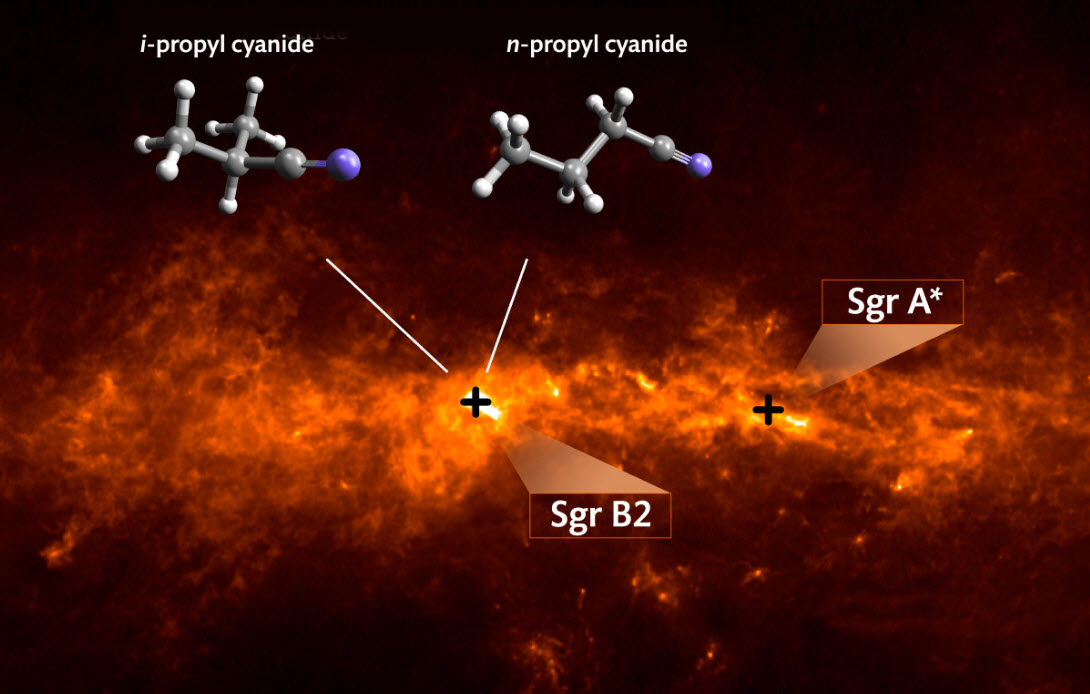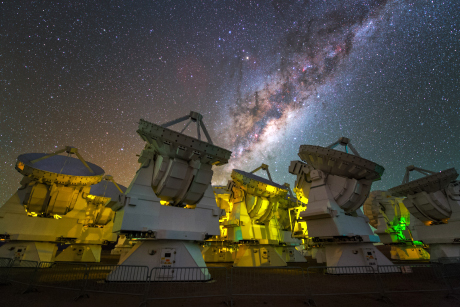New molecule found in space suggests life origins
September 30, 2014

Dust and molecules in the central region of our Galaxy: The background image shows the dust emission in a combination of data obtained with the APEX telescope and the Planck space observatory at a wavelength around 860 micrometers. The organic molecule iso-propyl cyanide with a branched carbon backbone (i-C3H7CN, left) as well as its straight-chain isomer normal-propyl cyanide (n-C3H7CN, right) were both detected with the Atacama Large Millimeter/submillimeter Array in the star-forming region Sgr B2, about 300 light years away from the Galactic center Sgr A*. (Credit: MPIfR/A. Weiß — background image, University of Cologne/M. Koerber — molecular models, amd MPIfR/A. Belloche — montage)
Astronomers have detected radio waves within a giant gas cloud in interstellar space corresponding to an unusual carbon-based molecule called isopropyl cyanide, needed for life, as described in the journal Science (Sept. 26.)

The Milky Way frames radio telescopes of the Atacama Large Millimeter/submillimeter Array, known as the ALMA Observatory, in Chile’s Atacama Desert (credit: . Beletsky/ESO)
Using the Atacama Large Millimeter/submillimeter Array, a group of radio telescopes known as the ALMA Observatory, researchers studied the gaseous star-forming region Sagittarius B2, located 27,000 light years away from Earth.
Organic molecules usually found in these star-forming regions consist of a single “backbone” of carbon atoms arranged in a straight chain. But the carbon structure of isopropyl cyanide branches off, making this the first interstellar detection of such a molecule, says Rob Garrod, Cornell senior research associate at the Center for Radiophysics and Space Research.
Life in space
This detection opens a new frontier in the complexity of molecules that can be formed in interstellar space and that might ultimately find their way to the surfaces of planets, says Garrod. The branched carbon structure of isopropyl cyanide is a common feature in molecules that are needed for life — such as amino acids, the building blocks of proteins.
This new discovery lends weight to the idea that biologically crucial molecules, like the amino acids commonly found in meteorites, are produced early in the process of star formation — even before planets such as Earth are formed — and reinforces the idea that life could exist elsewhere.
With ALMA, the group conducted a full spectral survey of the chemical makeup of Sagittarius B2, a region close to the Milky Way’s galactic center and an area rich in complex interstellar organic molecules, looking for fingerprints of new interstellar molecules, with sensitivity and resolution 10 times greater than previous surveys.
The purpose of the ALMA Observatory is to search for cosmic origins through an array of 66 sensitive radio antennas from the high elevation and dry air of northern Chile’s Atacama Desert, working together to form a gigantic “eye” peering into the cosmos.
About 50 individual features for isopropyl cyanide (and 120 for normal-propyl cyanide, its straight-chain sister molecule) were identified in the ALMA spectrum of the Sagittarius B2 region. The two molecules are also the largest molecules yet detected in any star-forming region.
Abstract of Detection of a branched alkyl molecule in the interstellar medium: iso-propyl cyanide
The largest noncyclic molecules detected in the interstellar medium (ISM) are organic with a straight-chain carbon backbone. We report an interstellar detection of a branched alkyl molecule, iso-propyl cyanide (i-C3H7CN), with an abundance 0.4 times that of its straight-chain structural isomer. This detection suggests that branched carbon-chain molecules may be generally abundant in the ISM. Our astrochemical model indicates that both isomers are produced within or upon dust grain ice mantles through the addition of molecular radicals, albeit via differing reaction pathways. The production of iso-propyl cyanide appears to require the addition of a functional group to a nonterminal carbon in the chain. Its detection therefore bodes well for the presence in the ISM of amino acids, for which such side-chain structure is a key characteristic.